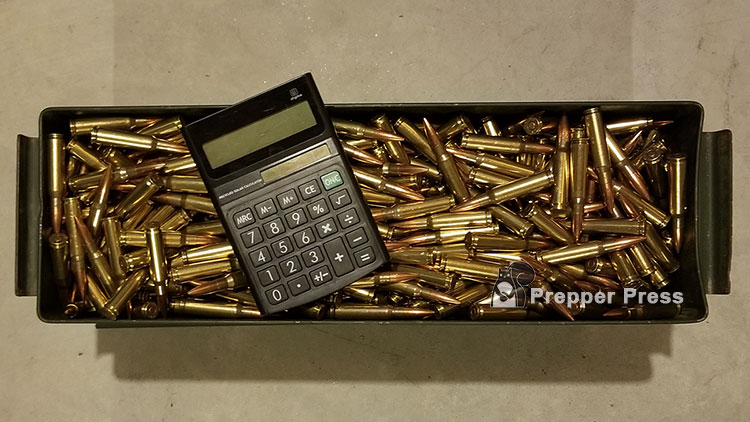
Judging by the chronically empty shelves at gun shops and “out of stock” notices online, folks seem to be buying ammunition at unprecedented rates. Preppers stock up on things, like toilet paper, by the case. Ammo is no different. So when they buy, they look for bulk ammo deals. But how much ammo do you need? We have built this ammo calculator and written this article as a guide.
As a note, while I am listed as the author here, it’s actually the result of a few minds coming together: myself, Steve Markwith, and my behind-the-scenes web guy who took our collective thoughts and turned them into an online ammo calculator.
The calculator is below, but to make the most sense of your results – and this subject as a whole – it is important to read the article through. It explains our reasoning behind the formulas in the calculator and will help you determine whether they’re accurate for you and how to adjust your results up or down.
Ammo Calculator
Ammo Calculator
Remember, these results are intended to be a guide only, for determining…
How Much Ammo Do You Really Need?
The standard answer to this question is MORE – always MORE! Unless you’re swimming, I suppose.
Repeating “more” and “more” does little to help someone actually trying to arrive at an actual figure, however. In fact, it’s not much of an answer at all. More is always better, but it’s good to have quantifiable goals, and “more” is not a goal that can ever be achieved. “More” just leads to unbalanced preps, too much money tied up in one area, and overkill.
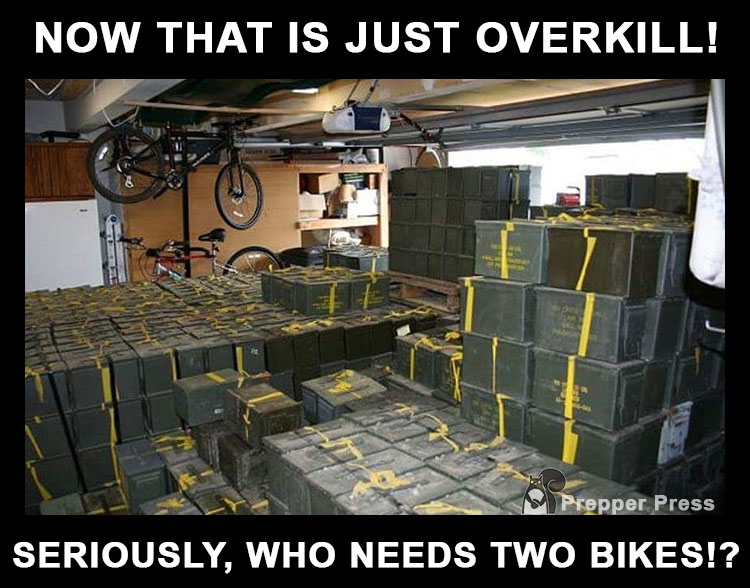
No Perfect Answer for Everyone
Everyone has different needs, prepping or otherwise. Further, everyone has different opinions. So, we wrote this article, and developed this ammo calculator, knowing full well that people may take issue with the end result. Our intent was to help people come up with an actual number, however, something they can either use as their goal or to adjust as needed. The results give you something to start with, some type of quantifiable answer to “how much ammo do you need?”
Defining Needs
Trying to determine your ammo needs for hypothetical situations involves a bit of methodology and a heavy dose of guesswork. It’s just a difficult figure to determine. Military forces have long struggled with this, ultimately pegging needs to the Table of Organization and Equipment (TOE). It’s a document that “prescribes the wartime mission, capabilities, organizational structure, and mission essential personnel and equipment requirements for military units.”
Using a light infantry company as an example, a TOE specifies its leadership and equipment requirements down through platoon and squad levels. The “equipment” aspect includes weapons and ammunition. Fielded to travel light, a rifleman’s “basic load” of 5.56 NATO is balanced against the weight of other gear and rations. Of course, most of these units deploy from bases holding larger reserves of ammunition, which is also a factor in determining needs.
While there may be certain similarities between military needs and prepper needs, they are distinctly two different categories. Prepping for a possible SHTF situation or some type of collapse is not the same as preparing for military combat, so simply referencing the TOE will not suit a prepper’s needs.
For our purposes, we mostly look at how much ammo preppers might need in four different areas:
- How much ammo do you need for training?
- How much ammo do you need for defense?
- How much ammo do you need for food gathering?
- How much ammo do you need for reserves or barter?
Again, need differ. One person might need more for survival while another might need more for defense. How much you need for training will depend on how often you shoot, how good you hope to become. Let’s start there…
How Much Ammo do You Need for Training and Practice?
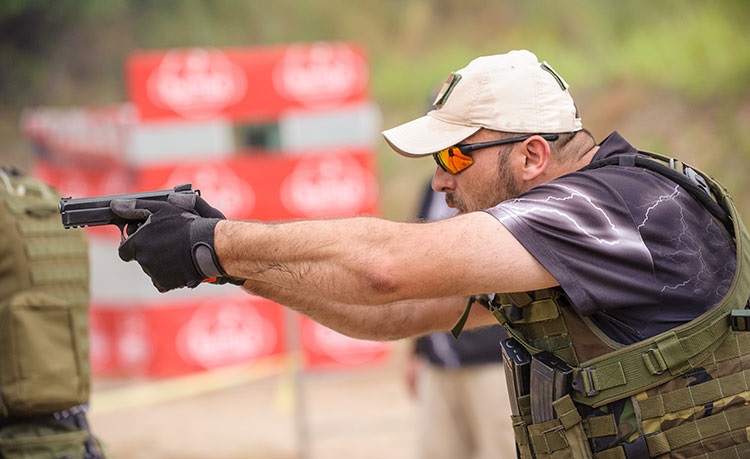
Marksmanship is a perishable skill. You’ll never forget how to shoot, but your aim will deteriorate without consistent practice. So, you need to ensure that you have an adequate supply of ammunition in order to keep your skills in check.
However, you have to be real. How much do you really practice? Personally, I always intend to shoot more than I actually do. I enjoy the shooting, but work, kids, this website – and the cost of ammunition – all contribute to getting less practice time in than I’d like. It’s simply reality. You might have a similar situation, or maybe you are a more avid shooter with more time and a fatter ammo wallet than what I have. Your training ammunition needs will differ.
For the ammo calculator, we created three shooter categories with annual assumptions on rounds fired:
| Shooter Type | Annual Handgun Rounds Fired | Annual Rifle Rounds Fired |
|---|---|---|
| Infrequent | 400 | 400 |
| Regular | 2400 | 2400 |
| Avid | 3600 | 3600 |
Infrequent Shooter. You can lump most firearm owners (including those with a gun for home defense) into this category. We assumed they’re firing an optimistic 400 rounds annually.
Regular Shooter. Not all, but at least some, will shoot monthly – or even weekly. A concealed-carry (CC) individual who can maintain this pace won’t be in Ninja level, but he or she will be in pretty good shape. The above ammo-chart reflects this activity.
Avid Shooter. Many of the people in this category trend toward competitive shooting, if only competing with themselves. These individuals have an annual (or sometimes monthly) ammo consumption measured by the case.
Another Way to Calculate Training Needs
Another, more accurate way to calculate your training needs is to take the amount of ammo you shoot per month and multiply it by 12 to give you your yearly training ammo requirement. If you shoot one box of 50 rounds of 9mm per month, that’s 50×12 or 600 9mm rounds per year.
You can cycle through your “training ammo” by shooting it, since proficiency will suffer without regular practice. The figure that follows is, perhaps, optimistic regarding commitment, especially with expense factored in.
And, of course, training ammo of the same caliber could cover more than one gun. In a pinch, you could even press it into service for defense! Note that recycled defensive rounds (more on those in a moment) can become part of this inventory.
The idea is maintain an ample supply consisting of well-proven and uniform types. Buying in bulk not only saves money. It also prevents a mish-mash of unproven brands and bullet-weights which shoot to different points of aim (POA).
Law Enforcement (LE) Training Ammo Needs
Steve’s view was to use common LE practices as the training floor. The reason? Most LEOs only shoot when paid to do so, which boils down to qualifications. Believe it or not, plenty of departments only shoot annually, expending, maybe, 100 – 150 rounds. In his experience, area semiannual qualifications are fairly common (300 max).
Some law enforcement departments with larger budgets in more temperate regions shoot quarterly (or more often). Tactical assets are typically smaller and more manageable so many (including Steve’s) squeak in monthly range sessions.
However, one thing they all have in common is in-depth initial training, typically at an academy level, involving hundreds of rounds. The same approach is strongly advised for civilians. Meanwhile, the above levels can help frame private citizen activity.
How Much Ammo Do You Need for Defense?

As we discussed, definitions matter. How much defensive ammo you need during a home invasion is quite different from what you’d need should we face TEOTWAWKI. Further, we have to define what “defensive” ammunition actually is. Is it the jacketed hollow points you carry in your defensive handgun, or is it larger quantities of ammunition for a prolonged crisis without the rule of law? We’ll cover both topics.
For the ammo calculator, we asked what kind of collapse situation you’re preparing for, and we associated an ammo count to each of those:
| Defensive Situation | Annual Handguns Rounds Needed | Annual Rifle Rounds Needed |
|---|---|---|
| Basic Home Supply | 1000 | 1000 |
| Preparing for an Extended Collapse | 2452 | 3400 |
| Zombie Apocalypse | 7352 | 8300 |
Basic Home Supply. We figured a standard 1000 rounds each of handgun and rifle ammunition. This is ver conservative. Some people feel the minimum is 1000 rounds per firearm.
Extended Collapse. We figured the basic home supply above plus 200 rounds per month might be fired for a period of one year (200 x 12 = 1252). This number, as you can imagine, is guesswork. For handgun, we also accounted for higher-end defensive ammunition, so we figured three 17-round magazines plus one in the chamber (17 x 3 + 1 = 52). This, of course, is added on top of your training figure, which should suffice as a “basic” home supply for the person who is not necessarily preparing for a SHTF situation.
Zombie Apocalypse. We figured 10 shots fired per day on average to stay alive against zombie hordes for a period of 2 years (10 x 365 x 2 + 52 = 7352). We then added the 52 rounds described above for handgun, which should be standard for all. For the rifle we topped it off with another 1000 rounds for good measure, because – zombies!
Again – guesswork. Can a zombie apocalypse really happen? If it does, you’ll be lucky to survive two years.
Steve noted that one of his instructors was a highly-ranked skeet shooter. He shot through 30,000 shells each year (120 cases), which were stacked throughout his house. No doubt, he’s staying put if there’s a zombie apocalypse. By the end of it there could be 30K horizontal zombies strewn around his property.
Bugging Out Note: If your plan is to bug out, you will be on the move with the goal of getting to safety. You don’t need a lot of ammo (hopefully) to get from point A to point B, and if you’re traveling by foot, your ammo count will be dictated by how much you can physically carry. You could figure the standard 52 defensive rounds. SUVs and pickups can carry a decent-sized load of ammo, so if bugging out to you means a cross-country road trip, up your count.
You may need to account for additional rounds to have at your BOL. Whatever you leave at home could wind up being an expensive gift for a very undeserving recipient raiding your vacant home.
A More In-Depth Look at Defensive Ammunition Needs
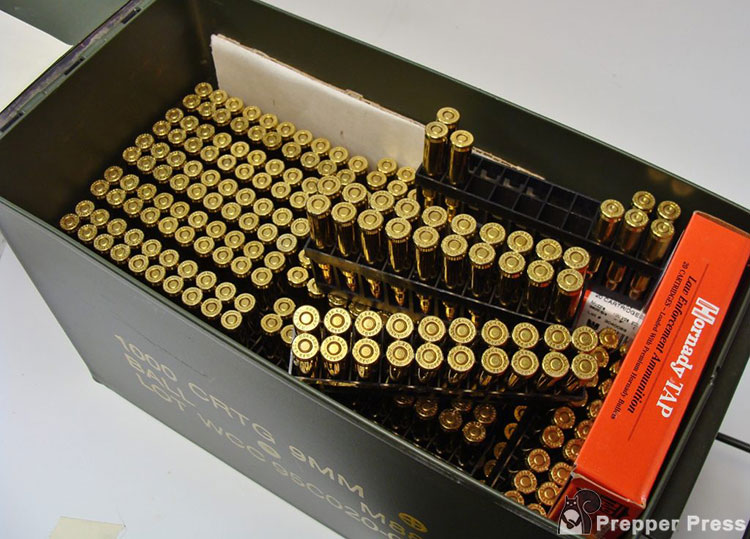
Because the need for defensive ammo can vary so widely, let’s dig further into the subject so you can have better context and have more information to adjust your count as needed. We can begin by looking at the ammunition expended in different situations.
Shootouts
I leaned on Steve’s expertise in this section greatly because of his many decades – literally – of experience.
He notes that even a squad of 8-9 soldiers can burn through some serious ammo. Because his old military team operated in the boonies, their loads often exceeded the norm. Still, he have run out of rifle ammo – not a good situation! He also burned through multiple 1911 .45 ACP mags on several occasions, one involving 8 ½ magazine’s worth.
Full-auto military fire can really suck through ammo, but the vast majority of LE and civilian excitement involves much less shooting – even with today’s semiautos. Hit probability has decreased as pistols have replaced revolvers, but total rounds expended remain low – typically just a few rounds.
Let’s look at some examples. A military squad equipped to travel light could have relevancy for civilians in serious bug out mode. For many of us though, the law enforcement examples may be more pertinent.
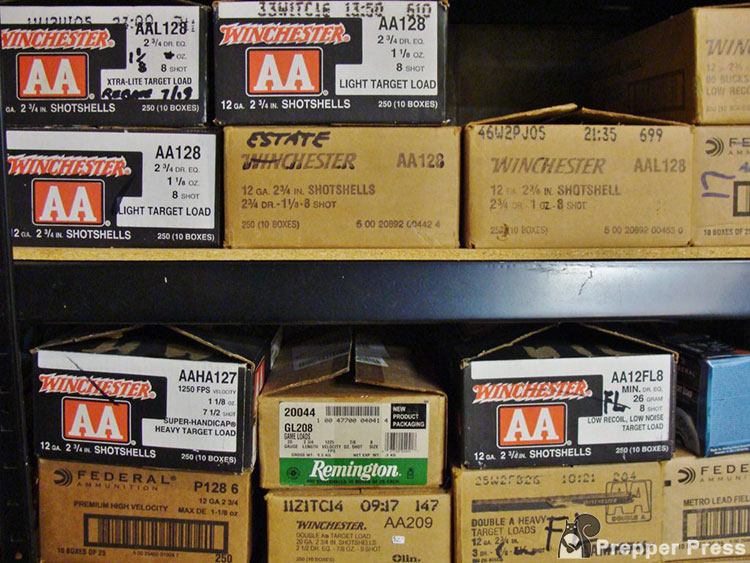
Military Riflemen
Today’s basic (or combat) load for a rifleman equipped with an M-4 (similar to an M-16) could be seven 30-round magazines. That’s 210 rounds of 5.56. Steve notes that in his days, everyone in his small recon-squad lugged 300 rounds (plus a spare 100-round belt of M-60 rounds). The extra firepower was a lifesaver deep in the bush but its weight, combined with other essentials, made for tough going.
Military Handgunners
Many basic loads probably mirror law enforcement; one full magazine in the pistol, plus two spares in a double-pouch. Interestingly, this practice hasn’t change much over time, although capacities have dramatically increased. The basic load for a trusty .45 ACP Model 1911 Pistol with its 7 +1 capacity worked out 22 rounds. The latest 9mm M-17, a 17+1 pistol, offers a boost to 52 rounds with two spare mags. Some troops lug more but, again, weight matters.
Steve seldom carried a pistol by itself, but when he did, thirteen spare 1911 magazines usually came along in a Claymore Mine pouch, slung over his shoulder. They added up to 99 rounds. Although doable, this heavy and floppy payload was not well-suited for an energetic retreat. Today, he’d swap it for much lighter but still effective 9mm JHPs and five spare 17-round mags.
Law Enforcement Handguns
By the early 1980s, I’d moved from OD Green to a blue uniform. At that time revolvers still ruled and the nearly-universal basic handgun load was 18 rounds of .38 Special or .357 Magnum. Six were in the revolver and 12 spare rounds were carried in two speed-loaders. Although skimpy by today’s standards, few of us fretted over the quantity. By comparison, today’s basic auto-pistol loads are stunning (and similar to the latest military M-17); somewhere around a box of 50 rounds.
Law Enforcement Rifles
There’s no hard and fast rule, but Steve’s department issues M-4 type AR-15s with three 30-round mags per carbine for a total of 90 rounds. Ammunition varies, depending on the situation.
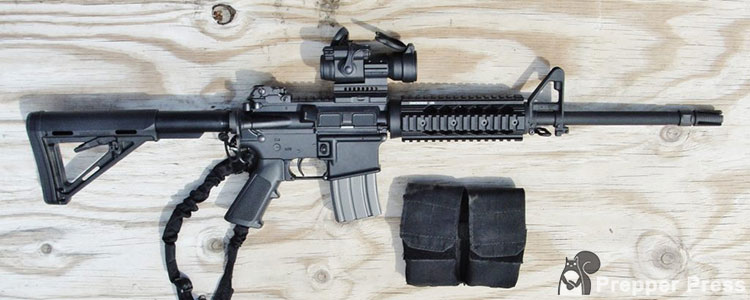
Law Enforcement Shotguns
This formidable close-range firearm still has a legitimate place. Steve’s department used Remington M-870s with extended mags (7 +1) and side-saddle shell holders (6) for a total of 13 lucky 00 Buckshot shells. FYI, it’s a heavy package when held at the ready.
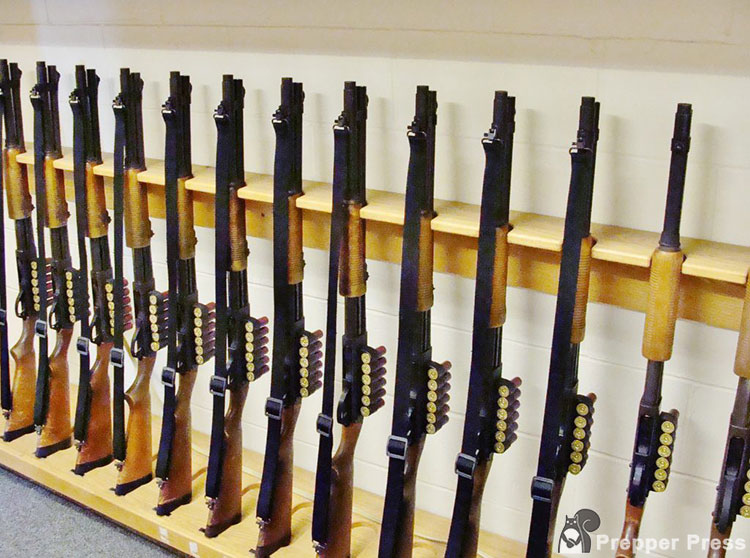
Sounds skimpy but each shell contains nine 00 Buckshot pellets.
Tactical LE Notes Many operators carry more magazines via special vests, in part thanks to tougher fitness standards. They fall more in line with military leg-unit examples.
Civilians?
Use the above as a guide. Many concealed carry (CC) folks will tote smaller handguns, often with less spare ammo – but please carry at least one reload to ward off Murphy’s Law!
High-End Defensive Ammo
If we look beyond simple ammo count for prolonged collapse situations, we can narrow in on higher-end defensive rounds that – for most people – are going to be too expensive to stock in large quantities.
Defensive ammo is expensive, but it’s (hopefully) consumed in small quantities. Practice requires more shooting but equivalent training loads cost much less. We could run dry though via piecemeal purchasing. But what’s enough?
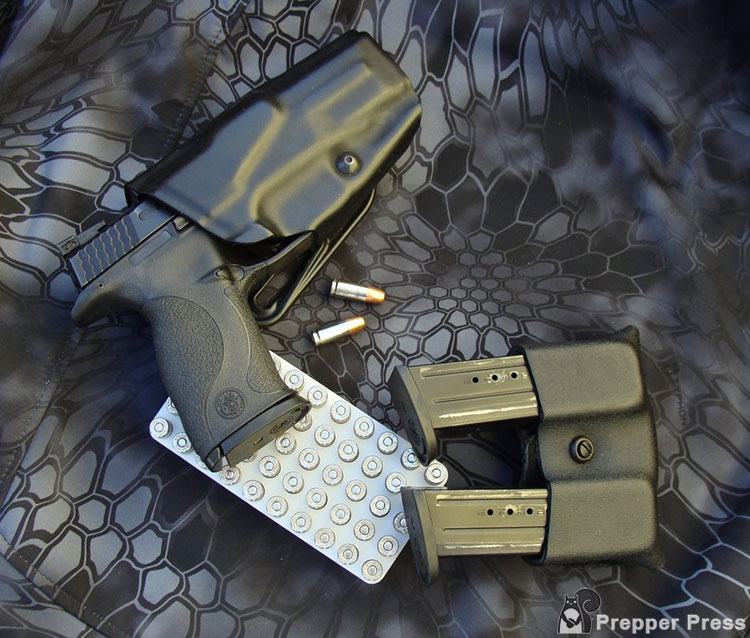
Typical of many hi-cap 17 +1 pistols, the “basic load” for this 9mm S&W M&P exceeds 50 rounds.
We factored in 52 rounds for reasoning already explained, but if you want to play it extra safe, plan on a year’s worth. The “Defensive Ammo” category constitutes the total per firearm. Using a typical hi-cap 9mm 17+1 pistol as an example, carried with two spare magazine, there is your “basic load” of 52 rounds. The capacity of many CC handguns is smaller and they’re often carried with only one spare magazine. Adjust as necessary to reflect your basic load.
| Defensive Ammo (JHP) Cycle it through your inventory | Rds |
| Basic load per firearm | 52 |
| Replacement rounds: A similar quantity to cover expenditures or damage | 52 |
| Rotation: Covers recommended annual replacement | 52 |
| Reserve: Covers any future shortages | 52 |
| Total on hand | 208 Rds |
How Much Ammo Do You Need for Food Gathering?
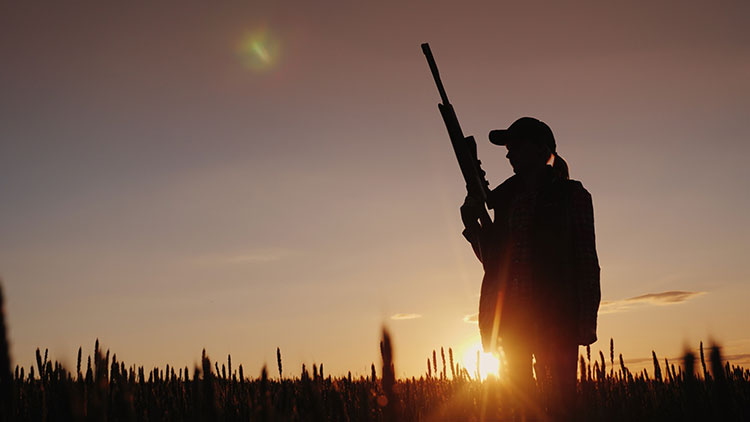
The idea that preppers will just go shoot wild game to survive after an apocalypse is foolhardy at best. Many people have this idea, it’s the easy/lazy way to food preps. Every hunter will be thinking the same thing, creating fierce competition for game and quickly depleting the stock of free range critters. However, it’s still something worth planning on because you just never know what might happen, and that’s the very reason we prep in the first place.
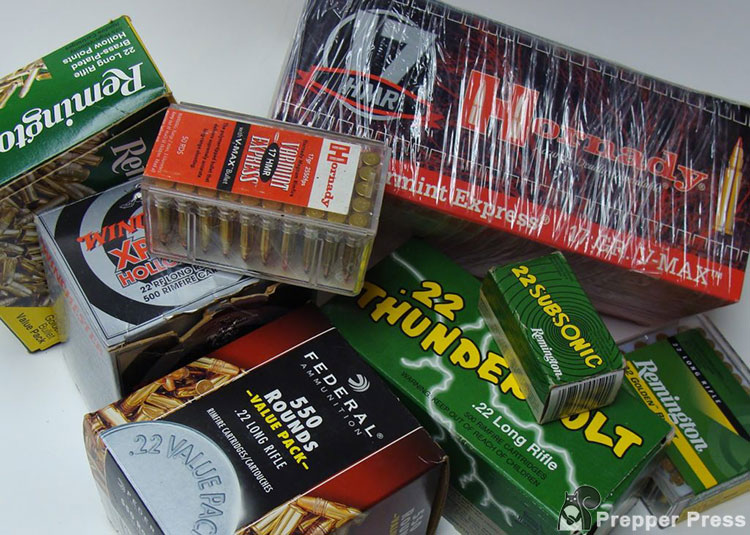
For the ammo calculator, we assumed an average of 3 rifle rounds per large game animal and one large game animal per month (used this as our source). We also figured 3 shots per small critter, which would likely mean lower-cost rimfire ammunition hunting gray squirrels (or whatever), and one small critter per day. For good measure we also assumed 10 birds per month at 2 shots per bird. Assuming a two-year extended survival situation, that equates to 2,712 rounds of mixed ammunition.
| Animal | Animals per Month | Shots Per Animal | Total Rounds for 2 Years |
|---|---|---|---|
| Large Game | 1 | 3 | 72 |
| Small Game | 30 | 3 | 2160 |
| Birds | 10 | 2 | 480 |
How Much Ammo Do You Need for Reserves or Barter?
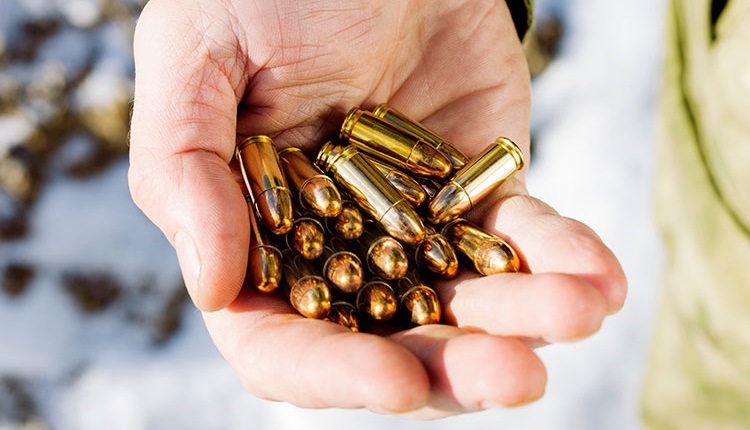
This brings us to the final consideration of how much ammo you need. How much are you going to need for reserves? How much will you need for barter?
A Question of Reserves
Anyone that has been shooting long enough has experienced the swings in the market, often associated with political swings or major global conflicts. Nothing is more frustrating than a desire to hit the range for a bit of fun only to find ammo excessively expensive or altogether unavailable. It happens too frequently, and the only way around this cycle is to buy it cheap and stack it deep – when you can.
Steve, for his part, was tasked with procuring ammunition for a large state agency. Their annual total constituted several hundred-thousand rounds. The associated headaches familiar to individuals included the same shortages and budget constraints. They saved money by lumping everything into one large yearly purchase. Because shortages were increasingly common, he tried to stay a year ahead on high-volume “Q-loads” used for training and qualification. You may want to adopt this approach to your supply if space and budget allow for it.
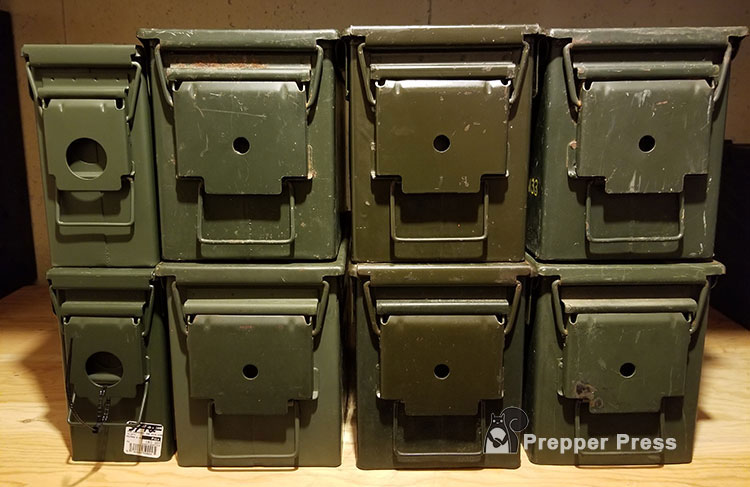
Keep in mind as well that it’s unlikely you’ll be surviving solo post-collapse. If you’re a diligent prepper, you probably have some form of contingency plan for family and close friends. Some of them may not have any firearms experience at all when they show up to your retreat or they may show up with firearms but no ammunition. Expect the unexpected.
Multiple Firearms
Another factor is whether you are planning to stock extra for multiple firearms. Further, if you are training to be proficient on different firearms, you are now tasked with stocking training ammo for each type. Costs add up as quickly as storage space shrinks. Plan carefully.
For the ammo calculator, we gave you three options:
| Basic Supply is Fine | Add Reserves | Add Extra Reserves |
|---|---|---|
| No additional ammo was added. | 20% was added to your total. | 40% was added to your total. |
A Question of Bartering
Silver for preppers has its place. During times of economic upheaval, precious metals come through as a strong store of value. It’s great for moving your wealth during evacuation, as Jews did in WW2. However, in a total collapse situation, it’s unlikely you’re going to be trading silver coins for canned goods. Maybe, but what might have equal – or more value would be ammunition in common calibers.
Larger quantities of ammo offer more than pure defense. If society unravels, food, fuel, and higher-demand calibers could assume new currency status.
Some may object to this idea entirely, the idea of giving ammunition to someone who could turn around and use it against you. Personal decision here, but for the ammo calculator we gave you two options:
| No Bartering Ammo | I’ll Barter |
|---|---|
| No additional ammo was added. | 10% was added to your total. |
Too Complicated?
Does the ammo calculator have your head spinning? Here’s a simplified formula. It’s geared toward those with larger gun collections who might want to account for each gun owned. These quantities should cover a one year period. Restock as funds and availability permit.
| Defensive Ammo | Basic load X 4, per firearm. |
| Training Ammo | 1800 (provides 100 practice-rounds monthly, plus a reserve*). |
What if money or space are tight? Well, you could probably cut the above by 50% without entering panic-mode, but I wouldn’t want to go much lower, particularly with inconsistent availability.
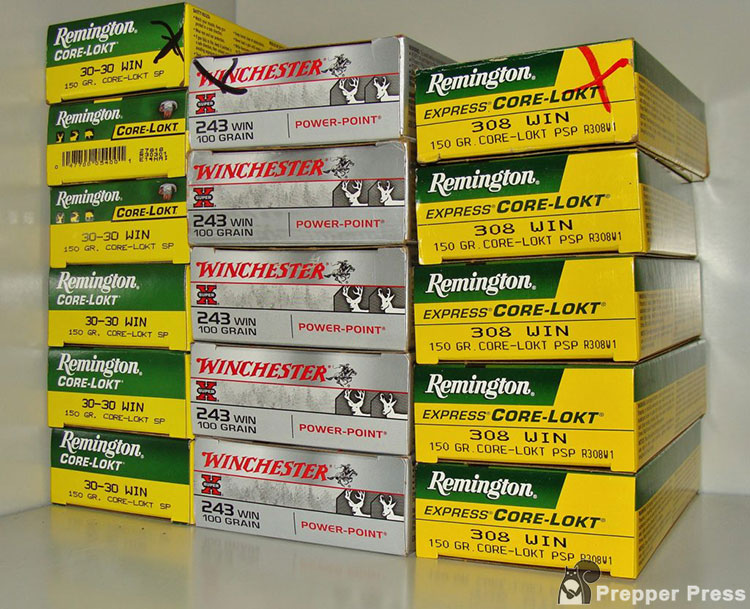
How to Stock that Ammo
Assuming your ammo supply is in a relatively secure, cool and dry location, it’ll last. A possible downside? Although a private ammo depot can be a good thing, it could be large enough to be immobile. This will be a lesser concern for those planning on staying put.
How to actually stock all of that ammo for long-term storage, that’s a lengthy subject we’ve covered in another article: How to Buy Ammo Cheap and Stock it Deep.
Your Thoughts?
There is no correct, perfect answer to this question of how much ammo you need. Our ammo calculator was just a guide to start from. The information that followed was additional thoughts for consideration.
On that note – what are your thoughts? Let us know in the comments. Find holes in our formulas? Did we project too high, too low, just right?
No comments:
Post a Comment